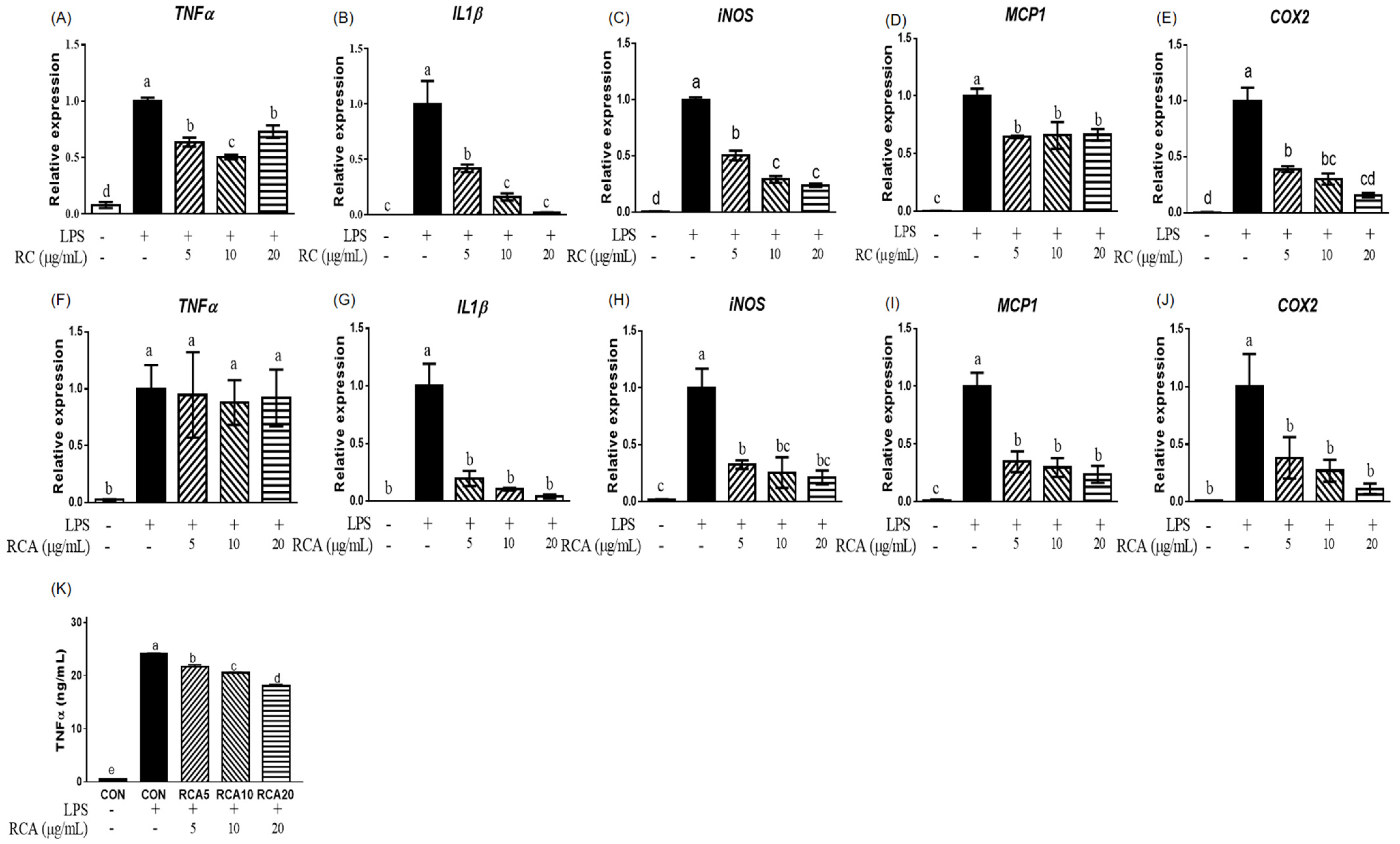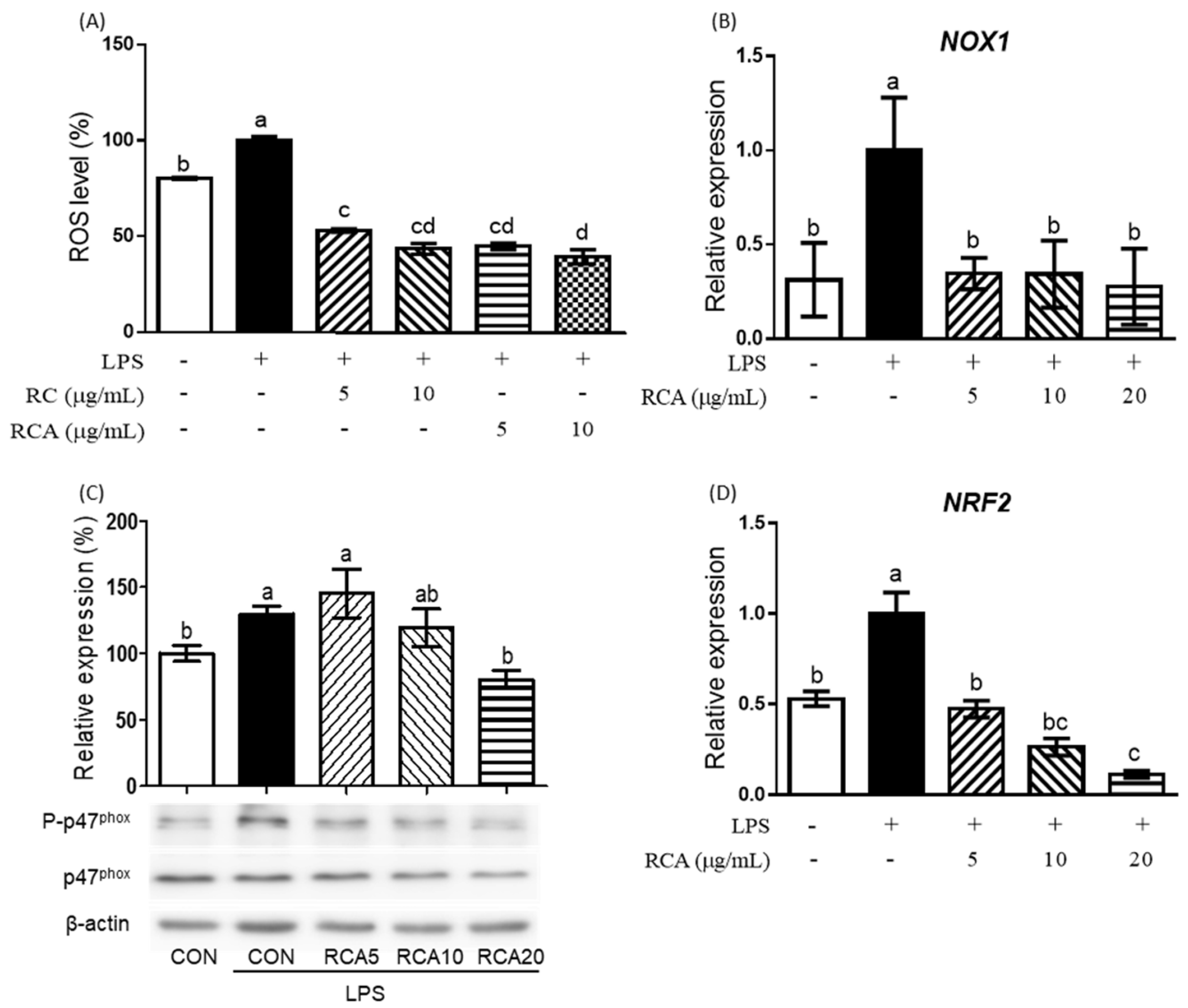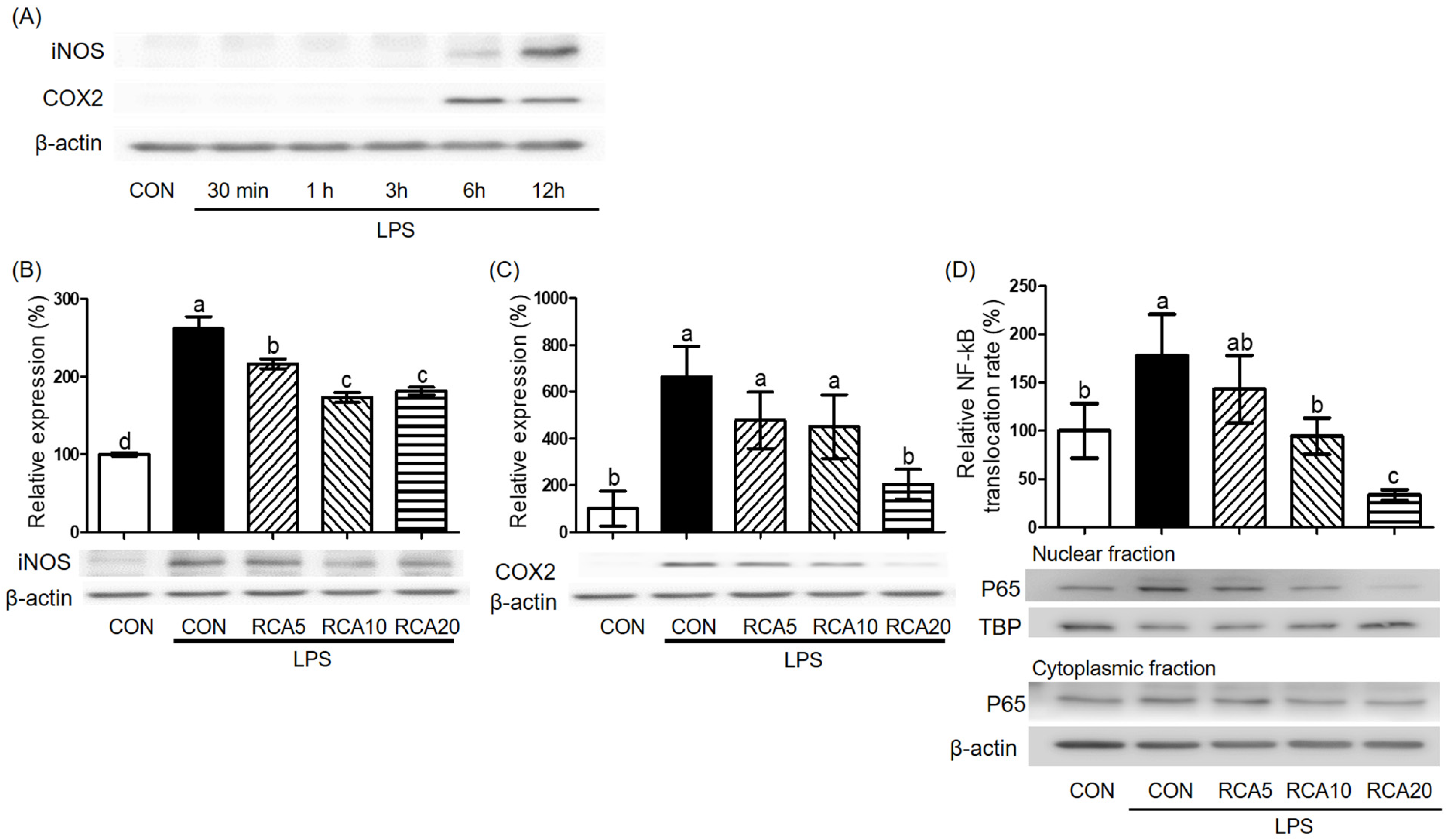Anti-Inflammatory and Antioxidant Effects of Anthocyanins of Trifolium pratense (Red Clover) in Lipopolysaccharide-Stimulated RAW-267.4 Macrophages
Abstract
1. Introduction
2. Materials and Methods
2.1. Preparation of Anthocyanin Fractions from Red Clover
2.2. Cell Culture
2.3. Measurement of Intracellular ROS
2.4. Quantitative Polymerase Chain Reaction (qPCR) Analysis
2.5. Enzyme-Linked Immunosorbent Assay (ELISA) for TNFα
2.6. Western Blot Analysis
2.7. Identification and Quantification of Red Clover Polyphenols Using HPLC/ESI-MS Analysis
2.8. Statistical Analysis
3. Results
3.1. RC and RCA Decreased the Expression of Genes Related to Pro-Inflammatory Markers
3.2. RC and RCA Inhibited LPS-Induced ROS Production
3.3. RCA Inhibited the Activation of NF-kB in LPS-Induced RAW 264.7 Cells
3.4. Identification and Quantification of Red Clover Polyphenols
4. Discussion
5. Conclusions
Author Contributions
Funding
Conflicts of Interest
References
- Coates, P.M.; Blackman, M.; Betz, J.; Cragg, G.M.; Levine, M.; Moss, J.; White, J.D. Encyclopedia of Dietary Supplements; CRC Press: New York, NY, USA, 2010; pp. 665–679. [Google Scholar]
- Booth, N.L.; Piersen, C.E.; Banuvar, S.; Geller, S.E.; Shulman, L.P.; Farnsworth, N.R. Clinical studies of red clover (Trifolium pratense) dietary supplements in menopause: A literature review. Menopause 2006, 13, 251–264. [Google Scholar] [CrossRef] [PubMed]
- Van de Weijer, P.H.; Barentsen, R. Isoflavones from red clover (Promensil) significantly reduce menopausal hot flush symptoms compared with placebo. Maturitas 2002, 42, 187–193. [Google Scholar] [CrossRef]
- Lipovac, M.; Chedraui, P.; Gruenhut, C.; Gocan, A.; Stammler, M.; Imhof, M. Improvement of postmenopausal depressive and anxiety symptoms after treatment with isoflavones derived from red clover extracts. Maturitas 2010, 65, 258–261. [Google Scholar] [CrossRef] [PubMed]
- Hidalgo, L.A.; Chedraui, P.A.; Morocho, N.; Ross, S.; San Miguel, G. The effect of red clover isoflavones on menopausal symptoms, lipids and vaginal cytology in menopausal women: A randomized, double-blind, placebo-controlled study. Gynecol. Endocrinol. 2005, 21, 257–264. [Google Scholar] [CrossRef]
- Castaneda-Ovando, A.; de Lourdes Pacheco-Hernández, M.; Páez-Hernández, M.E.; RodrÃguez, J.A.; Galán-Vidal, C.A. Chemical studies of anthocyanins: A review. Food Chem. 2009, 113, 859–871. [Google Scholar] [CrossRef]
- Yousuf, B.; Gul, K.; Wani, A.A.; Singh, P. Health benefits of anthocyanins and their encapsulation for potential use in food systems: A review. Crit. Rev. Food Sci. Nutr. 2016, 56, 2223–2230. [Google Scholar] [CrossRef]
- Zhu, Y.; Ling, W.; Guo, H.; Song, F.; Ye, Q.; Zou, T.; Li, D.; Zhang, Y.; Li, G.; Xiao, Y.; et al. Anti-inflammatory effect of purified dietary anthocyanin in adults with hypercholesterolemia: A randomized controlled trial. Nutr. Metab. Cardiovasc. Dis. 2013, 23, 843–849. [Google Scholar] [CrossRef]
- Selvaraju, V.; Ayine, P.; Fadamiro, M.; Babu, J.R.; Brown, M.; Geetha, T. Urinary biomarkers of inflammation and oxidative stress are elevated in obese children and correlate with a marker of endothelial dysfunction. Oxid. Med. Cell Longev. 2019, 2019, 9604740. [Google Scholar] [CrossRef]
- Tsuda, T. Dietary anthocyanin-rich plants: Biochemical basis and recent progress in health benefits studies. Mol. Nutr. Food Res. 2012, 56, 159–170. [Google Scholar] [CrossRef]
- Tak, P.P.; Firestein, G.S. NF-kappaB: A key role in inflammatory diseases. J. Clin. Invest. 2001, 107, 7–11. [Google Scholar] [CrossRef]
- Huang, W.Y.; Liu, Y.M.; Wang, J.; Wang, X.N.; Li, C.Y. Anti-inflammatory effect of the blueberry anthocyanins malvidin-3-glucoside and malvidin-3-galactoside in endothelial cells. Molecules 2014, 19, 12827–12841. [Google Scholar] [CrossRef]
- Decendit, A.; Mamani-Matsuda, M.; Aumont, V.; Waffo-Teguo, P.; Moynet, D.; Boniface, K.; Richard, E.; Krisa, S.; Rambert, J.; Merillon, J.M.; et al. Malvidin-3-O-beta glucoside, major grape anthocyanin, inhibits human macrophage-derived inflammatory mediators and decreases clinical scores in arthritic rats. Biochem. Pharmacol. 2013, 86, 1461–1467. [Google Scholar] [CrossRef]
- Serra, D.; Paixao, J.; Nunes, C.; Dinis, T.C.; Almeida, L.M. Cyanidin-3-glucoside suppresses cytokine-induced inflammatory response in human intestinal cells: Comparison with 5-aminosalicylic acid. PLoS ONE 2013, 8, e73001. [Google Scholar] [CrossRef]
- Li, K.; Zhang, M.; Chen, H.; Peng, J.; Jiang, F.; Shi, X.; Bai, Y.; Jian, M.; Jia, Y. Anthocyanins from black peanut skin protect against UV-B induced keratinocyte cell and skin oxidative damage through activating Nrf 2 signaling. Food Funct. 2019, 10, 6815–6828. [Google Scholar] [CrossRef]
- Krenn, L.; Paper, D.H. Inhibition of angiogenesis and inflammation by an extract of red clover (Trifolium pratense L.). Phytomedicine Int. J. Phytother. Phytopharm. 2009, 16, 1083–1088. [Google Scholar] [CrossRef]
- Mueller, M.; Hobiger, S.; Jungbauer, A. Red clover extract: A source for substances that activate peroxisome proliferator-activated receptor Î ± and ameliorate the cytokine secretion profile of lipopolysaccharide-stimulated macrophages. Menopause 2010, 17, 379–387. [Google Scholar] [CrossRef]
- Lee, S.G.; Parks, J.S.; Kang, H.W. Quercetin, a functional compound of onion peel, remodels white adipocytes to brown-like adipocytes. J. Nutr. Biochem. 2017, 42, 62–71. [Google Scholar] [CrossRef]
- Park, Y.K.; Rasmussen, H.E.; Ehlers, S.J.; Blobaum, K.R.; Lu, F.; Schlegal, V.L.; Carr, T.P.; Lee, J.Y. Repression of proinflammatory gene expression by lipid extract of Nostoc commune var sphaeroides Kutzing, a blue-green alga, via inhibition of nuclear factor-kappaB in RAW 264.7 macrophages. Nutr. Res. (New York, NY.) 2008, 28, 83–91. [Google Scholar] [CrossRef]
- Cho, M.J.; Howard, L.R.; Prior, R.L.; Clark, J.R. Flavonoid glycosides and antioxidant capacity of various blackberry, blueberry and red grape genotypes determined by high-performance liquid chromatography/mass spectrometry. J. Sci. Food Agric. 2004, 84, 1771–1782. [Google Scholar] [CrossRef]
- Fan, J.; Heller, N.M.; Gorospe, M.; Atasoy, U.; Stellato, C. The role of post-transcriptional regulation in chemokine gene expression in inflammation and allergy. Eur. Respir. J. 2005, 26, 933–947. [Google Scholar] [CrossRef]
- Kontoyiannis, D.; Pasparakis, M.; Pizarro, T.T.; Cominelli, F.; Kollias, G. Impaired on/off regulation of TNF biosynthesis in mice lacking TNF AU-rich elements: Implications for joint and gut-associated immunopathologies. Immunity 1999, 10, 387–398. [Google Scholar] [CrossRef]
- Surh, Y.J.; Chun, K.S.; Cha, H.H.; Han, S.S.; Keum, Y.S.; Park, K.K.; Lee, S.S. Molecular mechanisms underlying chemopreventive activities of anti-inflammatory phytochemicals: Down-regulation of COX-2 and iNOS through suppression of NF-kappa B activation. Mutat. Res. 2001, 480, 243–268. [Google Scholar] [CrossRef]
- Murakami, A.; Ohigashi, H. Targeting NOX, INOS and COX-2 in inflammatory cells: Chemoprevention using food phytochemicals. Int. J. Cancer 2007, 121, 2357–2363. [Google Scholar] [CrossRef]
- Bedard, K.; Krause, K.H. The NOX family of ROS-generating NADPH oxidases: Physiology and pathophysiology. Physiol. Rev. 2007, 87, 245–313. [Google Scholar] [CrossRef]
- El-Benna, J.; Dang, P.M.; Gougerot-Pocidalo, M.A.; Marie, J.C.; Braut-Boucher, F. p47phox, the phagocyte NADPH oxidase/NOX2 organizer: Structure, phosphorylation and implication in diseases. Exp. Mol. Med. 2009, 41, 217–225. [Google Scholar] [CrossRef]
- O′Leary, D.P.; Bhatt, L.; Woolley, J.F.; Gough, D.R.; Wang, J.H.; Cotter, T.G.; Redmond, H.P. TLR-4 signalling accelerates colon cancer cell adhesion via NF-kappaB mediated transcriptional up-regulation of Nox-1. PLoS ONE 2012, 7, e44176. [Google Scholar] [CrossRef]
- Lee, S.G.; Kim, B.; Yang, Y.; Pham, T.X.; Park, Y.K.; Manatou, J.; Koo, S.I.; Chun, O.K.; Lee, J.Y. Berry anthocyanins suppress the expression and secretion of proinflammatory mediators in macrophages by inhibiting nuclear translocation of NF-kappaB independent of NRF2-mediated mechanism. J. Nutr. Biochem. 2014, 25, 404–411. [Google Scholar] [CrossRef]
- Khorasani Esmaeili, A.; Mat Taha, R.; Mohajer, S.; Banisalam, B. Antioxidant activity and total phenolic and flavonoid content of various solvent extracts from in vivo and in vitro grown Trifolium pratense L. (Red Clover). Biomed Res. Int. 2015, 2015, 643285. [Google Scholar] [CrossRef]
- Booth, N.L.; Overk, C.R.; Yao, P.; Burdette, J.E.; Nikolic, D.; Chen, S.N.; Bolton, J.L.; Van Breemen, R.B.; Pauli, G.F.; Farnsworth, N.R. The chemical and biologic profile of a red clover (Trifolium pratense L.) phase II clinical extract. J. Altern. Complement. Med. 2006, 12, 133–139. [Google Scholar] [CrossRef]
- Dedio, W.; Clark, K.W. Influence of cytokinins on isoflavone and anthocyanin synthesis in red clover seedlings. Pestic. Sci. 1971, 2, 65–68. [Google Scholar] [CrossRef]
- Wu, X.; Prior, R.L. Systematic identification and characterization of anthocyanins by HPLC-ESI-MS/MS in common foods in the United States: Fruits and berries. J. Agric. Food Chem. 2005, 53, 2589–2599. [Google Scholar] [CrossRef]
- Jabri, M.A.; Rtibi, K.; Ben-Said, A.; Aouadhi, C.; Hosni, K.; Sakly, M.; Sebai, H. Antidiarrhoeal, antimicrobial and antioxidant effects of myrtle berries (Myrtus communis L.) seeds extract. J. Pharm. Pharmacol. 2016, 68, 264–274. [Google Scholar] [CrossRef]



| Gene | Forward | Reverse |
|---|---|---|
| COX2 | GCCTACTACAAGTGTTTCTTTTTGCA | CATTTTGTTTGATTGTTCACACCAT |
| GAPDH | GGTGGTCTCCTCTGACTTCAACA | GTTGCTGTAGCCAAATTCGTTGT |
| IL1β | GTCACAAGAAACCATGGCACAT | GCCCATCAGAGGCAAGGA |
| iNOS | AATCTTGGAGCGAGTTGTGG | CAGGAAGTAGGTGAGGGCTTG |
| MCP1 | CTTCTGGGCCTGCTGTTCA | CCAGCCTACTCATTGGGATCA |
| NOX1 | TTCACAGTTATTCATATCATTGC | AGAGAACAGAAGCGAGAG |
| NRF2 | CTCGCTGGAAAAAGAAGTG | CCGTCCAGGAGTTCAGAGG |
| TNFα | GGCTGCCCCGACTACGT | ACTTTCTCCTGGTATGAGATAGCAAAT |
| Number | RT (min) | Isoflavone Derivatives | Amount (μg/g dw) | [M-H]-m/z |
|---|---|---|---|---|
| 1 | 27.1 | Luteolin 7-O-β-D-glucoside | 368.5 ± 14.7 | 449, 287 |
| 2 | 28.7 | unknown tetrahydroxyflavone glucoside | 2394.3 ± 28.0 | 449, 287 |
| 3 | 29.2 | unknown tetrahydroxyflavone glucoside | 1356.2 ± 18.0 | 449, 287 |
| 4 | 31.5 | Isoquercitrin-6″-O-malonate | 1677.9 ± 20.9 | 551, 303 |
| 5 | 32.3 | Pratensein-7-O-β-D-glucoside | 682.1 ± 6.3 | 463, 301 |
| 6 | 33.4 | Genistin | 12892.3 ± 35.6 | 433, 271, 153 |
| 7 | 33.9 | Hyperoside | 3103.0 ± 20.9 | 465, 303 |
| 8 | 34.3 | Isoquercetriin | 8940.1 ± 16.6 | 465, 303 |
| 9 | 35.0 | Apigenin-7-O-β-D-glucoside | 512.1 ± 1.7 | 433, 271 |
| 10 | 36.1 | Pseudobaptigenin | 5809.6 ± 14.0 | 283 |
| 11 | 37.0 | unknown tetrahydroxyflavone glucoside | 24560.7 ± 60.7 | 449, 287 |
| 12 | 38.4 | Kaempferol or Luteolin | 5022.7 ± 37.8 | 287 |
| 13 | 38.9 | Gemosteom-7-O-β-D-glucoside-6″-O-malonate | 17933.8 ± 123.6 | 519, 271 |
| 14 | 39.3 | unknown tetrahydroxyflavone glucoside | 2691.2 ± 13.6 | 449, 287 |
| 15 | 40.2 | 3-methylquercetin-7-O-β-D-glucoside | 7838.7 ± 7.6 | 479, 317 |
| 16 | 42.7 | Kaempferol or Luteolin | 12876.9 ± 16.1 | 287 |
| 17 | 44.3 | Pratensein-7-O-β-D-glucoside-6″-malonate | 2437.5 ± 8.8 | 549, 317 |
| 18 | 44.9 | Pseudobaptigenin-7-O-β-D-glucoside | 2280.1 ± 8.4 | 445, 283 |
| 19 | 45.5 | Kaempferol or Luteolin | 2213.7 ± 9.1 | 287 |
| 20 | 46.7 | Glycitein | 312.1 ± 15.1 | 285, 167 |
| 21 | 47.5 | Pseudobaptigenin-7-O-β-D-glucoside-6″-O-malonate | 2361.1 ± 47.3 | 445, 283, 137 |
| 22 | 52.2 | Formononetin-7-O-β-D-glucoside-6″-O-malonate | 2231.1 ± 19.0 | 517, 269 |
| 23 | 53.7 | Calysosin-Glucoside-Malonate | 213.7 ± 15.9 | 533, 285, 137 |
| 24 | 57.0 | Prunetin-4′-O-β-D-glucoside-6″-O-malonate | 2089.3 ± 38.1 | 533, 285 |
| 25 | 58.7 | Formononetin | 497.3 ± 13.6 | 269, 137 |
| 26 | 60.2 | Biochanin A-7-O-β-D-glucoside-6″-O-malonate | 3713.8 ± 3.1 | 533, 285 |
| 27 | 66.8 | Biochanin A | 1059.8 ± 14.8 | 285 |
| Total | 128069.5 ± 628.9 |
| Number | RT (min) | Anthocyanins | Amount (μg/g dw) | [M-H]-m/z |
|---|---|---|---|---|
| 1 | 27.5 | Delphinidin-3, 5-O-diglucoside | 139.0 ± 1.1 | 627, 465, 303 |
| 2 | 29.9 | Cyanidin-3-O-galactoside | 380.3 ± 2.2 | 449,287 |
| 3 | 31.5 | Cyanidin-3-O-glucoside | 47.7 ± 3.3 | 449,287 |
| 4 | 33.5 | Petunidin-3-O-galactoside | 145.5 ± 4.4 | 479,317 |
| 5 | 34.4 | Peonidin-3-O-galactoside | 633.6 ± 5.5 | 463,301 |
| 6 | 36.3 | Malvidin-3-O-galactoside | 2129.4 ± 6.6 | 493,331 |
| 7 | 37.3 | Petunidin-3-O-rutinoside | 123.9 ± 7.7 | 625,479,317 |
| Total | 3599.5 ± 10.4 |
© 2020 by the authors. Licensee MDPI, Basel, Switzerland. This article is an open access article distributed under the terms and conditions of the Creative Commons Attribution (CC BY) license (http://creativecommons.org/licenses/by/4.0/).
Share and Cite
Lee, S.G.; Brownmiller, C.R.; Lee, S.-O.; Kang, H.W. Anti-Inflammatory and Antioxidant Effects of Anthocyanins of Trifolium pratense (Red Clover) in Lipopolysaccharide-Stimulated RAW-267.4 Macrophages. Nutrients 2020, 12, 1089. https://doi.org/10.3390/nu12041089
Lee SG, Brownmiller CR, Lee S-O, Kang HW. Anti-Inflammatory and Antioxidant Effects of Anthocyanins of Trifolium pratense (Red Clover) in Lipopolysaccharide-Stimulated RAW-267.4 Macrophages. Nutrients. 2020; 12(4):1089. https://doi.org/10.3390/nu12041089
Chicago/Turabian StyleLee, Sang Gil, Cindi R. Brownmiller, Sun-Ok Lee, and Hye Won Kang. 2020. "Anti-Inflammatory and Antioxidant Effects of Anthocyanins of Trifolium pratense (Red Clover) in Lipopolysaccharide-Stimulated RAW-267.4 Macrophages" Nutrients 12, no. 4: 1089. https://doi.org/10.3390/nu12041089
APA StyleLee, S. G., Brownmiller, C. R., Lee, S.-O., & Kang, H. W. (2020). Anti-Inflammatory and Antioxidant Effects of Anthocyanins of Trifolium pratense (Red Clover) in Lipopolysaccharide-Stimulated RAW-267.4 Macrophages. Nutrients, 12(4), 1089. https://doi.org/10.3390/nu12041089






